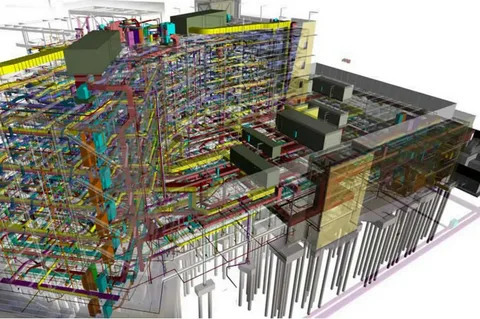The Future of Design: How Technology Is Shaping Smarter Buildings
October 24, 2025 | by IoT Development Company

Walk into a modern office building today. You’ll notice something’s different. The lights? They adjust themselves. Temperature feels perfect without anyone fiddling with the thermostat. Security systems actually recognize your face now.
This isn’t some sci-fi movie. It’s happening right now. Smart buildings are everywhere, and honestly, they’re completely changing how we think about design and architecture.
When Buildings Started Thinking for Themselves
Remember motion-sensor lights in bathrooms? That used to be cutting-edge tech. Those days are ancient history now. We’re talking about buildings that genuinely think. They learn. They adapt to whoever’s inside them.
The shift was gradual at first. Then everything changed super fast. Architects figured something out. They weren’t just creating static spaces anymore. They were building living ecosystems that actually respond to people.
Check out these numbers. Back in 2022, there were 45 million smart buildings worldwide. By 2026? Experts predict 115 million. That’s not just growth. That’s a total transformation of construction and design.
Here’s the kicker. Most aren’t homes. About 90% are commercial spaces. Why? Businesses caught on quick. Lower operational costs plus happier employees? That’s a no-brainer for the bottom line.
The Technology That Makes It All Work
So what’s going on behind those walls? It’s not magic, though it sure feels like it sometimes. Smart buildings run on four main things working together.
First, AI systems process real-time data. They trigger automatic responses. Second, IoT sensors collect everything. Movement, temperature, air quality—you name it. Third, automation systems connect HVAC, lighting, and access controls. Fourth, data analytics with machine learning interprets all this information.
Think of it as a nervous system. Sensors are like nerve endings. They constantly feed info to the brain—the AI systems. Then the brain tells the muscles what to do. Those are the automation controls.
The beauty? How seamlessly it all works. Someone walks into a conference room. Sensors detect them immediately. Lights brighten to perfect levels. Temperature adjusts to their preferred setting. The room’s calendar updates automatically.
All of this happens in microseconds. Nobody presses a single button.
Integrating these technologies takes serious planning. You need to think about it from day one. Modern architectural teams embed intelligence right into the blueprints. They’re mapping complex networks of sensors and data flows. Everything needs to work perfectly from the start.
Artificial Intelligence: The Real Game Changer
AI is flipping the script on building design. Architects can now simulate thousands of energy models in minutes. They forecast operational costs years ahead. They identify the best material combinations before construction even begins.
This isn’t about replacing human creativity. Not at all. It’s about amplifying it. Designers test ideas that would’ve taken months to prototype before. They explore possibilities that were totally impractical just a few years ago.
In 2025, AI stopped being a cool novelty. It became a problem-solving beast. Building management systems are way smarter now. They’re proactive about responding to facility needs.
We’re seeing truly autonomous building controls emerge. These systems don’t just react to problems. They predict them before they happen. Imagine your HVAC system knowing a heat wave is coming. Three days in advance. It automatically pre-cools spaces during off-peak hours. You save massive amounts on electricity.
The predictive maintenance stuff is wild. Instead of waiting for equipment to break down, AI analyzes HVAC data constantly. It predicts potential failures before they happen. Facilities managers can do proactive maintenance. Less downtime. Lower costs.
No more firefighting. You’re strategically maintaining buildings based on actual data, not gut feelings.
How Designers Are Adapting Their Approach
The architectural world had to evolve big time. Traditional drafting methods? They don’t work anymore. Not when you’re building structures that house complex tech ecosystems.
Drafting teams now integrate placeholders during design. Sensors, fiber optics, smart panelsall mapped out in construction documents. This saves massive headaches later. Working with specializedbim services new york helps coordinate the technical requirements perfectly.
Nobody wants to retrofit smart tech into an unprepared building. It’s ridiculously expensive. Super disruptive. And it often compromises how well the system works.
Design teams work totally differently now. Cloud-based drafting environments let teams from multiple cities collaborate. They work on the same model simultaneously. Coordination happens between different locations in real-time. Accuracy improves dramatically. Project timelines accelerate by at least 30%.
This collaborative approach matters because smart building design needs multiple specialists. Mechanical engineers. Electrical contractors. IT professionals. Traditional architects. Everyone needs to speak the same language.
The Human Element: Making Technology Feel Natural
Here’s what people forget about smart buildings. The technology should be invisible. Users shouldn’t notice it at all.
The best smart designs create responsive environments. They learn from how people actually behave. Office lighting adjusts to concentration patterns throughout the day. Retail spaces shift temperature zones based on where shoppers are moving.
When technology works perfectly? People don’t see it. They just feel comfortable and productive. They don’t even know why.
Smart buildings prioritize occupant health now. They incorporate biophilic design elements. Natural light. Greenery everywhere. Fresh air constantly circulating. Plus wellness-focused tech like circadian lighting. Air purification systems running 24/7.
This is where smart design becomes genuinely humanistic. It’s not about cramming gadgets into every corner. It’s about using technology to create better spaces. Spaces that make people feel good. Help them think clearly. Work more effectively.
Energy Efficiency: The Practical Benefit Everyone Cares About
Let’s talk money. That’s what drives adoption in commercial real estate, right? Smart buildings deliver serious energy savings. No question about it.
Advanced HVAC systems use AI to optimize climate control now. They adapt to occupancy patterns. They respond to external weather conditions. You’re not cooling empty conference rooms anymore. You’re not heating vacant floors.
The systems learn when and where people actually are. Then they adjust accordingly. Simple as that.
Some smart buildings combine renewable energy sources. Solar panels. Geothermal systems. They generate their own power. With smart grid tech, they can even sell excess energy back. They become net-positive energy producers.
This is a complete mindset shift. Buildings aren’t just resource consumers anymore. They’re active participants in the energy ecosystem. They generate power during peak production times. Feed it back to the grid when demand spikes. Working with architectural bim services helps model these complex energy flows before construction starts.
The Edge in Amsterdam proves what’s possible. This building earned recognition as one of the world’s greenest. Smart technology manages everything. Energy consumption. Security. Occupant comfort. All of it.
It’s not just theoretically efficient. It’s proving smart buildings operate at a fraction of traditional energy costs. While providing way better working conditions.
Looking Ahead: What’s Coming Next
One futuristic advancement is gaining serious interest. Augmented reality for facilities staff. AR headsets provide real-time building navigation. Interactive guides overlay right on their field of view. Maintaining complex equipment becomes way more efficient. Fewer errors too.
Picture this. A technician looks at equipment. They see its complete service history floating in front of them. Current operating parameters. Step-by-step repair instructions. All in their field of vision. That’s coming soon. Really soon.
The walled-garden approach is crumbling. Proprietary systems are losing favor. Clients demand flexibility and future-proofing now. 2025 is seeing major players embrace open-source platforms. They’re doing it with real substance too.
This shift toward interoperability is huge. Building owners don’t want vendor lock-in. They want systems that talk to each other. Systems that integrate new tech as it emerges. Systems that adapt over decades.
The Challenges We’re Still Solving
Not everything is perfect yet. Obviously. The path to smart building benefits has obstacles. We need standards so systems work together. We need strategies for privacy and data security.
When your building knows where you are constantly? When it knows your temperature preferences? When it tracks what time you arrive at work? That’s a ton of personal information floating around.
Building managers need to be thoughtful. Designers need to be thoughtful. Data protection matters. User privacy matters.
Cost is another real concern. The upfront investment for smart building tech can be substantial. However, operational savings typically justify the expense. Usually within a few years.
Energy costs drop dramatically. Maintenance becomes predictive instead of reactive. Occupant satisfaction improves measurably. Still, convincing stakeholders to make that initial investment? You need solid data. Compelling projections.
Why This Matters for Everyone
We spend roughly 90% of our lives inside buildings. Think about that statistic for a second. It should make us care deeply about how buildings function.
Smart building technologies create a built environment that’s sustainable. Efficient. Human-centric. Each improvement makes buildings more than just spaces. They become dynamic entities. They interact with people and the environment meaningfully.
The future isn’t just about buildings consuming less energy. Though that’s a fantastic benefit. It’s not just about requiring less maintenance. Though that’s great too.
It’s about creating environments that actively support human flourishing. Buildings that help us focus when we need concentration. That promote collaboration when we need teamwork. That provide quiet retreats when we need to recharge.
Technology is finally catching up. It matches our understanding of how physical spaces affect human behavior. How they affect wellbeing.
For architects, engineers, contractors, and building owners? This represents both challenge and extraordinary opportunity. The industry is being completely reimagined right now. Those who embrace the change will thrive. Those who develop expertise in smart building design will define the next generation.
Those who resist will find themselves increasingly irrelevant. Harsh but true.
The Bottom Line
The transformation we’re witnessing isn’t subtle at all. Buildings are becoming intelligent partners. They’re part of how we live and work now. They learn our patterns throughout the day. They anticipate what we need. They adapt in real-time to make everything easier.
This isn’t coming someday in the distant future. It’s happening right now. In cities around the world. In buildings people use every single day.
As we keep pushing boundaries, one thing becomes crystal clear. Tomorrow’s buildings won’t just be places where stuff happens. They’ll be active participants in making those things happen better. Way better.
RELATED POSTS
View all



